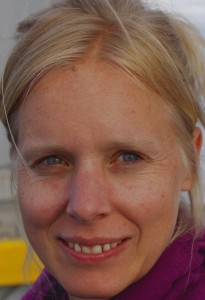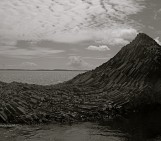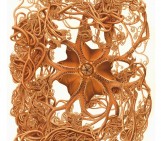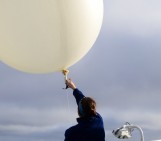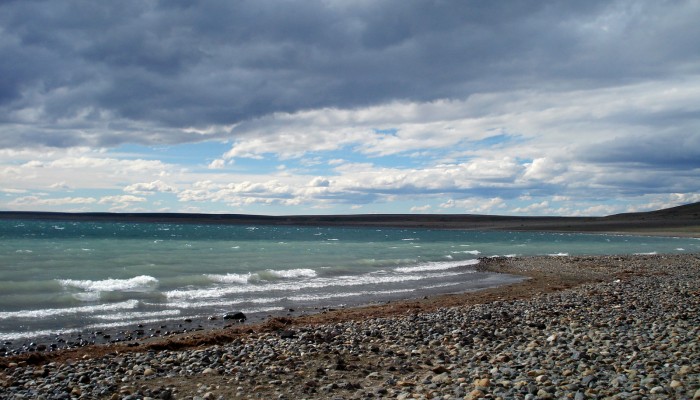
Geotalk is a regular feature highlighting early career researchers and their work. Following the EGU General Assembly, we spoke to Katrin Schroeder, the winner of a 2015 Arne Richter Award for Outstanding Young Scientists.
First, could you introduce yourself and tell us a little more about your career path so far
I am a physical oceanographer with a background in environmental science. I did my studies at the University of Venice(Italy) and in collaboration with the Institute for Marine Sciences of the Italian National Research Council (CNR-ISMAR). I started off working on biogeochemical cycles in coastal waters and then moved to the larger scale and to the physics of ocean dynamics in the open sea, trying also to combine physical and biogeochemical oceanography. In 2006 I started to work at CNR ISMAR in La Spezia, on the shore of the Ligurian Sea, in a beautiful office with sea view, reminding me every morning how lucky I was to have my job. I finally got a permanent position at CNR ISMAR in Venice in 2011. This period was characterized by intense learning, participation to workshops, summer schools and conferences, prolonged visits at the National Oceanography Centre in Southampton, writing my PhD thesis and papers, and participating in oceanographic cruises of the Mediterranean Sea, 1-2 months per year. I slowed down this rhythm recently, but just a bit, after the birth of my first son (now 3 years old), and my two twin boys (now 1 year old). I am looking forward to go back out to sea again soon.
What sparked your interest in oceanography?
At the beginning it was more or less by chance that I started to work on the Mediterranean Sea, and became a physical oceanographer, since after several applications to various marine and environmental institutes in 2004 I got my first fellowship at the Unit for Marine Research (ENEA in La Spezia). After my first oceanographic cruise, in 2005, in the Western Mediterranean Sea, I knew that that was “my” job. At that time there was no internet on research vessels and offshore the mobile phones served only to help you to wake up in time for your next shift in the middle of the night (these vessels operate 24/24 hours): you were completely in another dimension for days or weeks, without any contact with the “outside world”, working hard and in close contact with a limited number of persons. For me, that was great. What I really love in my job as a sea-going physical oceanographer is the alternation between “thinking” phases (in the office, in front of a pc) and “operating” phases (the cruise, the pre and post activities).
Much of your research focuses on the Mediterranean Sea, what makes it such an ideal candidate for oceanographic studies?
The Mediterranean has a number of valuable advantages (besides, CNR ISMAR being on its door steps). It is in many ways a miniature ocean and a natural laboratory for climatic studies: it has deep water formation varying on interannual time scales and a well-defined overturning circulation, and there are distinct surface, intermediate and deep water masses circulating between the western and the eastern basin. What makes the Mediterranean particularly useful for climate change studies is that its time scale is much shorter than for the global ocean, with a turnover time of roughly 60 years compared with more than 500 years for the global ocean. Changes can happen faster, on the time scale of a human lifetime.
During EGU 2015, you received the Arne Richter Award for Outstanding Young Scientists for your work on experimental oceanography, where you have contributed original ideas on the understanding of the formation and spreading of Mediterranean deep waters. Could you tell us a bit more about your research in this area?
In the deep layers of the Western Mediterranean an almost constant trend towards higher salinity and temperature has been observed since the ‘50s. More recent observations evidenced an acceleration of this tendency. An alteration of the water mass vertical distribution, associated with an abrupt temperature and salinity increase has been observed. In particular, since March 2005 large volumes of new bottom water has formed in the northwestern Mediterranean Sea. Remarkably this new bottom water is warmer and saltier than the old deep waters so it has become an easily recognized water mass when temperature and salinity profiles are made through the water column. Since its formation, this new bottom water has spread out into the western Mediterranean so that now it forms a bottom layer of warm salty water up to 1000 m thick throughout the western Mediterranean basin. The new bottom water has provided a natural tracer release experiment for understanding how bottom water fills the basin. The processes of deep water formation, the filling of the western Mediterranean with the new deep waters formed in the north, and the mixing between old and new deep waters are keys to understand how the Mediterranean is changing under changing climate conditions. An important open issue is how the old and new deep waters mix, on what time scale and by what processes, and in particular to quantify the role of turbulent mixing in the overall diffuse upwelling, the returning branch of the vertical thermohaline circulation.
The possible impacts these changes could have on a global scale are still an open issue.
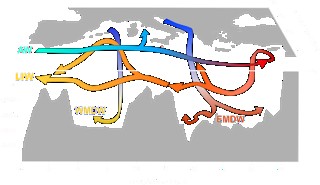
Mediterranean thermohaline circulation (modified by Loic Houpert from Tsimplis et al., 2006): AW=Atlantic Water, LIW=Levantine Intermediate Water, WMDW=Western Mediterranean Deep Water, EMDW=Eastern Mediterranean Deep Water. Credit: Katrin Schroeder
With my team we observed the anomaly thanks to repeated oceanographic cruises in the Western Mediterranean. We started to publish about the deep water formation event in the north-western Mediterranean in 2006 (Schroeder et al., 2006, GRL). The event was extraordinary for its large volume of warmer and thermohaline properties of the deep water produced during the severe winter of 2004/2005. I have explored the causes of this event, tracing its origin back to the Eastern Mediterranean, from where increased amounts of heat and salt were imported to the Western Mediterranean and I have examined with new observations the spreading of the new water as a transient tracer through the western Mediterranean.
How does bottom water form, exactly and how is it different to other water in Mediterranean?
Bottom water forms in some specific regions worldwide, and few of them are also located in the Mediterranean Sea. Deep waters are “formed” (or we should rather say “transformed” from surface and intermediate water masses) where the air temperatures are cold and where the salinity of the surface waters are relatively high. The combinations of salinity and cold temperatures make the water denser and cause it to sink to the bottom. Its formation may occur either in the open ocean by deep convection or on the continental shelves by a process called dense shelf water cascading. In the Mediterranean both phenomena are present: in the Gulf of Lion (north-western Mediterranean Sea), in the Adriatic Sea and in the Aegean Sea. This sites maintain the Mediterranean thermohaline circulation in motion and, ventilating the deep layers, provide fresh oxygen to the deep water ecosystems. The Mediterranean also hosts a surface water mass, which comes directly from the Atlantic Ocean and circulates through the whole basin, gradually increasing its density because of the strong evaporation that takes place in the region. In the Mediterranean intermediate water masses are also formed, with processes that are similar to the bottom water formation, but in different locations and with density characteristics that do not allow these water masses to sink to the very bottom.
Earlier, you mentioned that the Mediterranean is useful for climate change studies due to having a much quicker turnover than the larger oceans. Can you describe an example of just how the study of the Mediterranean has been useful in this way?
The most important example is the in depth investigation of the process of deep water formation, which is an essential component of the global ocean conveyor belt, and sustains the present climatic state. The process happens mostly at high latitudes, but also in the north-western Mediterranean Sea on much smaller scales. Observations of the processes involved in open-ocean deep convection began with the now classical Mediterranean Ocean Convection (MEDOC) experiment in the Gulf of Lion [MEDOC Group, 1970]. With respect to high latitude sites, the Mediterranean site had the advantages of being less expensive to investigate, given an easier access with oceanographic vessels, due to its closeness to the coast and oceanographic institutes, of offering to milder winter conditions (season during which the dense water formation takes place) facilitating operations at sea. It is also very likely that studies about process related to ocean acidification and carbon sequestration as a consequence of dense water formation will be more feasible in the Mediterranean Sea.
What advice do you have for early career scientists on how achieve a good work/life balance?
Well, this is strongly dependent on the specific conditions you have in your life and it depends on your priorities: I have strong support from my family, I have the possibility to have a kindergarten close to our home with an affordable fee (this is the most important thing I must say!), and I have made the choice to let the household behind ….and I do not iron!
Finally, could you tell us a bit about your future research plans?
Staying very general, I am starting to follow a path of a higher interdisciplinary in oceanographic disciplines, trying to enforce the dialogue between us, physical oceanographers, and biological, microbiological and chemical oceanographers, as well as with climatologists and meteorologists.
References
Schroeder K., Gasparini G.P., Tangherlini M., Astraldi M.: Deep and Intermediate Water in the Western Mediterranean under the influence of the Eastern Mediterranean Transient. Geophys. Res. Lett. 33, doi: 10.1028/2006GL02712

